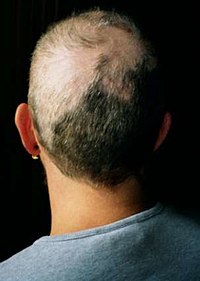
Photo from wikipedia
Trichotillomania (TTM) is a disorder characterized by repetitive hair-pulling resulting in hair loss. Key processes affected in TTM comprise affective, cognitive, and motor functions. Emerging evidence suggests that brain matter… Click to show full abstract
Trichotillomania (TTM) is a disorder characterized by repetitive hair-pulling resulting in hair loss. Key processes affected in TTM comprise affective, cognitive, and motor functions. Emerging evidence suggests that brain matter aberrations in fronto-striatal and fronto-limbic brain networks and the cerebellum may characterize the pathophysiology of TTM. The aim of the present voxel-based morphometry (VBM) study was to evaluate whole brain grey and white matter volume alteration in TTM and its correlation with hair-pulling severity. High-resolution magnetic resonance imaging (3 T) data were acquired from 29 TTM patients and 28 age-matched healthy controls (CTRLs). All TTM participants completed the Massachusetts General Hospital Hair-Pulling Scale (MGH-HPS) to assess illness/pulling severity. Using whole-brain VBM, between-group differences in regional brain volumes were measured. Additionally, within the TTM group, the relationship between MGH-HPS scores, illness duration and brain volumes were examined. All data were corrected for multiple comparisons using family-wise error (FWE) correction at p < 0.05. Patients with TTM showed larger white matter volumes in the parahippocampal gyrus and cerebellum compared to CTRLs. Estimated white matter volumes showed no significant association with illness duration or MGH-HPS total scores. No significant between-group differences were found for grey matter volumes. Our observations suggest regional alterations in cortico-limbic and cerebellar white matter in patients with TTM, which may underlie deficits in cognitive and affective processing. Such volumetric white matter changes may precipitate impaired cortico-cerebellar communication leading to a reduced ability to control hair pulling behavior.
Journal Title: Brain Imaging and Behavior
Year Published: 2019
Link to full text (if available)
Share on Social Media: Sign Up to like & get
recommendations!